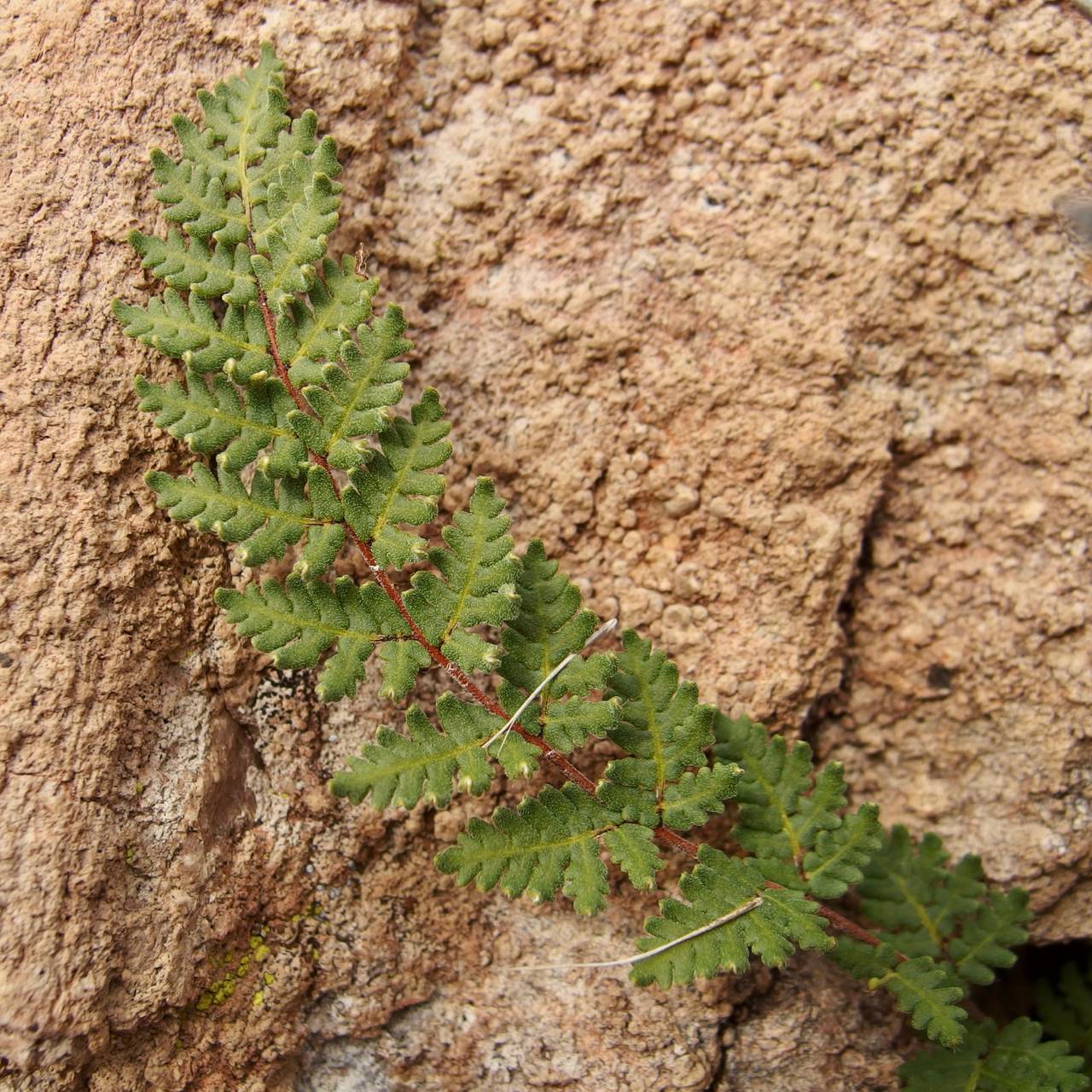
|
Family: Pteridaceae |
Plants usually on rock. Stems short-creeping to compact, ascending to horizontal, usually branched; scales black or often bicolored with dark central stripe and lighter margins, linear-subulate to lanceolate; margins ciliate, denticulate, or entire. Leaves monomorphic, clustered, 4--35 cm. Petiole brown or black, usually rounded, flattened, or with single longitudinal groove adaxially, often bearing scales, hairs, or farinose glands, with single vascular bundle. Blade linear-lanceolate, ovate, deltate, or pentagonal, pinnate-pinnatifid to 4-pinnate, leathery, abaxially covered by yellowish or whitish farina (completely obscured by stellate scales in Notholaena aschenborniana ), adaxially often sparsely glandular, dull, not striate; rachis straight. Ultimate segments of blade sessile to subsessile, often adnate to costae, narrowly elliptic to oblong-ovate or deltate, usually less than 4 mm wide; base rounded to truncate or cuneate; stalks (when present) usually lustrous and dark-colored; segment margins recurved to form confluent, poorly defined false indusia extending entire length of segment. Veins of ultimate segments free, obscure, pinnately branched and divergent distally. False indusia greenish, narrow, clearly marginal, occasionally concealing the sporangia. Sporangia confined to submarginal vein tips, containing 64, 32, or 16 spores, intermixed with farina-producing glands. Spores black to dark brown, globose or tetrahedral-globose, granulate, lacking prominent equatorial ridge. Gametophytes glandular-farinose (gametophytes of all other Pteridaceae genera lack farina). x = 30. As pointed out by R. M. Tryon (1956), J. T. Mickel (1979), and many others, Notholaena in the broad sense is poorly defined and difficult to distinguish from either Cheilanthes or Pellaea . North American taxa traditionally assigned to Notholaena represent at least four distinct evolutionary lineages (M. D. Windham 1986). In order to clarify species relationships and generic boundaries among cheilanthoid ferns, Notholaena is defined here in a very restricted sense. The pubescent, nonfarinose species (such as N . newberryi ) have been placed in Cheilanthes following R. M. Tryon and A. F. Tryon (1982). The scaly, nonfarinose taxa of the N . sinuata complex have been transferred to Astrolepis for reasons discussed by D. M. Benham and M. D. Windham (1992). The glabrous and farinose species related to Pellaea (e.g., N . jonesii and N . dealbata ) have been placed in Argyrochosma (M. D. Windham 1987). The species retained in Notholaena following this reorganization (i.e., members of the farinose N . grayi -- N . standleyi alliance) form a coherent, monophyletic group found only in the Western Hemisphere. The correct generic name for this group is in dispute because Notholaena has been lectotypified by several authors citing three different type species. The rules of priority favor the first typification (by J. Smith in 1875) based on N . trichomanoides (Linnaeus) Desvaux, which is definitely a member of the group here called Notholaena . R. E. G. Pichi-Sermolli (1989), however, urged acceptance of the typification by C. Christensen ([1905--]1906). Both the second and third lectotypifications of Notholaena were based on species unrelated to the North American taxa discussed here. If Smith's typification is overturned, the correct generic name for our species will be Chrysochosma (J. Smith) Kümmerle.
Much like Cheilanthes and Pellaea, and not sharply distinct from either; axes of the pinnae and pinnules in most spp. (including ours) up curled when dry, exposing the lower lf-surface; margins of the lf-segments flat to revolute, scarcely or not at all modified. 75, mostly dry New World. Gleason, Henry A. & Cronquist, Arthur J. 1991. Manual of vascular plants of northeastern United States and adjacent Canada. lxxv + 910 pp. ©The New York Botanical Garden. All rights reserved. Used by permission. |
This project was made possible in part by the Institute of Museum and Library Services [MG-70-19-0057-19].
Powered by Symbiota



